Advertisements
Online Mock Tests
Chapters
2: Simple Machines
3: Refraction of Light
4: Refraction through Lenses and Optical Instruments
5: Spectrum
6: Echoes and Vibrations of Sound
7: Electricity
8: Electric Power and House hold Circuits
▶ 9: Magnetic Effect of Current
10: Specific Heat Capacity and Latent Heat
11: Thermionic Emission and Radioactivity
![ICSE solutions for Physics [English] Class 10 chapter 9 - Magnetic Effect of Current ICSE solutions for Physics [English] Class 10 chapter 9 - Magnetic Effect of Current - Shaalaa.com](/images/physics-english-class-10_6:5f2b1b2038084cf381bfa42c826a928c.jpg)
Advertisements
Solutions for Chapter 9: Magnetic Effect of Current
Below listed, you can find solutions for Chapter 9 of CISCE ICSE for Physics [English] Class 10.
ICSE solutions for Physics [English] Class 10 9 Magnetic Effect of Current Short Answers
State whether a magnetic field is associated or not around a static charge.
State whether a magnetic field is associated or not around a moving charge.
State whether a magnetic field is associated or not around a current carrying conductor.
What is the nature of the lines of force of the magnetic field due to a straight current carrying wire?
What will happen to a compass needle when the compass is placed below a wire with needle parallel to it and a current is made to flow through the wire? Give a reason to justify your answer.
State two factors on which the strength of induced e. m.f. depends.
Describe briefly one way of producing an induced current in a coil. State one factor that determines the magnitude of induced e.m.f.
State the two properties of the magnetic lines of force around a circular coil.
A straight wire is held vertical and current is passed in it in the upward direction. A compass needle is kept near the wire in north of it. How is the needle deflected? What is the change in the deflection of the needle if the current in wire is reversed?
Describe a simple Experiment to demonstrate that there Exists a magnetic field around a current-carrying conductor.
State a law, which determines the direction of magnetic field around a current carrying wire.
A straight current-carrying conductor is kept in a magnetic field. It Experiences a force. State three factors on which the magnitude of force Experienced by the conductor depends. Under what condition will the conductor Experience no force?
State under what conditions force acting on a current carrying conductor which is freely suspended in a magnetic field can be maximum.
State under what conditions force acting on a current carrying conductor which is freely suspended in a magnetic field can be Zero.
State the purpose of the iron core.
How does a magnetic field set up by a solenoid change when number of turns are increased?
How does a magnetic field set up by a solenoid change when cross-sectional area of solenoid is increased?
How does a magnetic field set up by a solenoid change when a soft iron core is inserted inside solenoid?
How does a magnetic field set up by a solenoid change when strength of current in the solenoid is decreased?
State two ways by which the magnetic field due to a current carrying solenoid can be made stronger.
Why is soft iron generally used as the core of the electromagnet?
Name two factors on which the magnitude of an induced e.m.f. in the secondary coil depends.
What is an electromagnet? List any two uses.
State the condition when an electric charge can give rise to a magnetic field.
List some of the practical applications of an electromagnet.
What is a permanent magnet? Give one use of it.
State two advantages of an electromagnet over a permanent magnet.
State two advantages of an electromagnet over a bar magnet.
What will be the effect on the working of an electric bell if instead of a direct current an alternating current is used?
Name a common device that uses electromagnets.
Name the material used for making the armature of an electric bell. Give a reason for your answer.
What is an electric motor?
State the principle of an electric motor.
State three factors which govern the speed of rotation of an electric motor.
How will the direction of force be changed, if the current is reversed in the conductor placed in a magnetic field?
State the unit of magnetic field in terms of the force experienced by a current carrying conductor placed in a magnetic field
What energy conversion takes place during the working of a d c motor?
State the factors that can increase the speed of rotation of the coil in a D.C. motor.
State the energy change that takes’place in a D. C. motor.
State the principle of a D. C. motor.
State the position of armature coil relative to the direction of magnetic field, in a D. C. motor when the deflecting couple acting an the coil is maximum.
State the position of armature coil relative to the direction of magnetic field, in a D. C. motor when the deflecting couple acting and the coil is minimum.
What is electromagnetic induction?
State Lenz's Law.
What is dynomo (a.c. generator)? State the principle on which it works.
Suggest two ways in an a.c. generator to produce a higher e.m.f.
What is a transformer? On what principle does it work?
How are the e.m.f in the primary and secondary coils of a transformer related with the number of turns in these coils?
What is the function of a transformer in an a.c. circuit? How do the input and output powers in a transformer compare?
State the principle of a transformer.
Can a transformer be used with direct current source? Give reason.
State the factors on which the frequency of the alternating e.m.f. depends.
Name the principle on which functioning of a transformer depends.
What is the function of a step-up transformer?
Can a transformer work when it is connected to a D.C. source? Give a reason.
Why is the core of a transformer made of soft iron?
What is the function of a transformer in an a.c. circuit? How do the input and output powers in a transformer compare?
Why is the core of a transformer laminated?
What energy conversion does take place in a generator when it is in use?
The primary windings of a step-up transformer are usually made of thicker wire than the secondary. Explain.
ICSE solutions for Physics [English] Class 10 9 Magnetic Effect of Current Long Answers
State important properties (or characteristics) of magnetic lines of force around a straight conductor.
Name and state the law which determines the direction of induced current.
or
State Fleming’s right-hand rule.
State the factors, on which depends the magnitude of the force acting on current carrying conductor, when it is kept in a magnetic field perpendicular to it.
A current-carrying solenoid is suspended so as to freely rotate in a horizontal plane. State in what direction will it rest. Give a reason for your answer.
or
When a solenoid that is carrying current is freely suspended, it comes to rest in a particular direction. Why does this happen?
What are the factors that govern the magnitude of force acting on a current carrying conductor which is freely suspended in a magnetic field?
Name two factors on which the strength of magnetic field of an electromagnet depends and state how does it depend on the factors stated by you.
Point out three differences between an electromagnet and a bar (or permanent) magnet.
Why soft iron is preferred to be used as the core of the electromagnet of an electric bell?
State Fleming's left hand rule.
Name three losses of energy in a transformer. How are they minimized?
State Faraday's laws of electromagnetic induction.
ICSE solutions for Physics [English] Class 10 9 Magnetic Effect of Current Figure Based Short Answers
State and explain ‘Ampere’s Swimming Rule’ to determine the direction of magnetic field (or magnetic lines of force) around a current carrying conductor.
The diagram shows a current-carrying coil passing through a cardboard sheet. Draw three magnetic lines of force on the board.
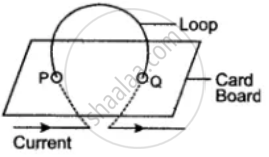
State two factors on which magnitude of magnetic field at the centre depends.
Sketch the lines of force of the magnetic field of a solenoid. How does its field compare with that of a bar magnet?
In the diagram XY is a straight conductor carrying current in the direction marked by the arrow. The conductor is held vertical by passing it through a horizontal cardboard sheet.
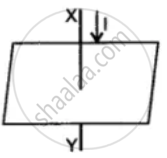
Draw three magnetic lines of force on the board and mark the direction of magnetic field in your diagram. State two factors on which magnitude of magnetic field at a point, depends.
State and explain Maxwell’s Cork Screw Rule.
State Fleming's left hand rule.
(i) A straight wire conductor passes vertically through a piece of cardboard sprinkled with iron filings. Copy the diagram and show the setting of iron filings when a current is passed through the wire in the upward direction and the cardboard is tapped gently. Draw arrows to represent the direction of the magnetic field lines.

(ii) Name the law which helped you to find the direction of the magnetic field lines.
State and illustrate the rule used for finding the polarity of the faces of a circular coil.
A flat coil of wire rotates at a constant speed about an axis perpendicular to a uniform magnetic field. Draw a graph to show how the induced e.m.f. varies relative to the positions of the coil during its one complete rotation. At what position of the coil, the e.m.f. has the maximum value?
The adjacent diagram shows a small magnet placed near a solenoid. State whether the magnet is attracted or repelled, as the switch is pressed. Give a reason.
What is a solenoid? Why do we usually keep its diameter small in comparison to its length?
What is an electromagnet? What do you know about the simplest form of an electromagnet?
Draw a labelled diagram to make an electromagnet from a soft iron bar. Mark the polarity at its ends in your diagram. What precaution would you observe while making it?
You have been provided with a solenoid AB.
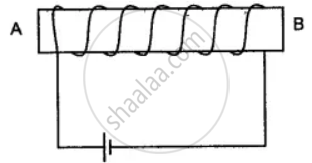
(i) What is the polarity at end A?
(ii) Give one advantage of an electromagnet over a permanent magnet.
State the function of a split ring in D.C. motor.
Draw a neat labeled diagram of an A.C. generator
State change that you would make to convert an A.C. generator into a D.C. generator. Illustrate the change by a diagram.
Draw a labelled diagram to show the various parts of a step-up transformer and step down transformer.
(i) Draw a clear labelled diagram of an electric bell.
(ii) Explain in brief, its working.
(iii) What material is used for the core of an electric bell? State the reason.
ICSE solutions for Physics [English] Class 10 9 Magnetic Effect of Current Figure Based Long Answers
Describe a set up for plotting the magnetic lines of force in: (i) A straight wire, (ii) A circular coil and (iii) A straight solenoid.
Describe an experiment to show that there is a magnetic field around a current carrying conductor.
The diagram shows a rectangular coil ABCD, suspended freely between the concave pole pieces of a permanent horseshoe magnet, such that the plane of the coil is parallel to the magnetic field.

(i) State your observation, when current is switched on.
(ii) Give an explanation for your observation in (i).
(iii) State the rule, which will help you to find the motion of rotation of coil.
(iv) In which position will the coil ultimately come to rest?
(v) State four ways of increasing the magnitude of force acting on the coil.
The given figures 1 to 3 show the working of a simple A.C. generator. Study the diagrams and answers of the following questions.
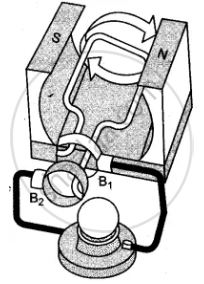
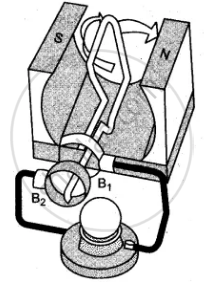
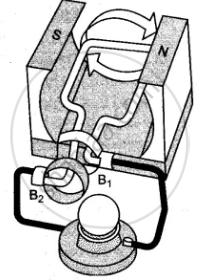
(i) State and explain the principle underlying the working of a simple generator.
(ii) Where is the loop of wire placed?
(iii) What happens when the loop is rotated?
(iv) Indicate the direction of the current flow through the wire for the first half of the turn (in first figure). Name and state the rule used in finding the direction of the current.
(v) Indicate the direction of the current for the case shown in second figure.
(vi) Indicate the direction of current in the outer circuit (i.e., electric bulb) in first and third figure.
(vii) What type of current is shown in the above diagrams? Explain.
Copy the given diagram of a transformer and complete it. Name the parts A and B. Name the part you have drawn to complete the diagram. What is the material of this part? Is this transformer a step-up or step-down? Give reason.
The power supply to the primary coil of a transformer is 200 W. Find
(i) Current in primary coil if the e.m.f. supply to it is equal to 220V.
(ii) The number of turns in the primary coil is equal to 80 and that in secondary is 800. What is the transformation ratio?
(iii) Name the type of transformer.
(iv) What will be the output voltage?
(v) What is the current in the secondary coil for an ideal transformer?
(vi) What is the output power?
(vii) Is output and input power equal?
(viii) Compare the current flowing in a secondary coil and in a primary coil.
ICSE solutions for Physics [English] Class 10 9 Magnetic Effect of Current Short Numericals
The primary coil of a transformer has 200 turns while the secondary coil has 1000 turns. What type of transformer is this? if the input voltage is 10V, what will be the output voltage?
Applying e.m. f to primary coil is 210 V. If the number of turns in primary coil is 200 turns and that of in secondary coil is 20 turns, then find out the output voltage. Name the type of transformer.
A transformer lowers e.m.f. 220 V to 12 volts. If the number of turns in primary are 8800, how many turns are in secondary coil?
A transformer lowers e.m.f. from 220 V to 15 V. If 400 W power is given in primary, calculate (i) the current in primary coil and (ii) the current in secondary coil.
A transformer lowers e.m.f. from 220 V to 15 V. If the number of turns in primary are 3520, how many turns are in the secondary coil?
Solutions for 9: Magnetic Effect of Current
![ICSE solutions for Physics [English] Class 10 chapter 9 - Magnetic Effect of Current ICSE solutions for Physics [English] Class 10 chapter 9 - Magnetic Effect of Current - Shaalaa.com](/images/physics-english-class-10_6:5f2b1b2038084cf381bfa42c826a928c.jpg)
ICSE solutions for Physics [English] Class 10 chapter 9 - Magnetic Effect of Current
Shaalaa.com has the CISCE Mathematics Physics [English] Class 10 CISCE solutions in a manner that help students grasp basic concepts better and faster. The detailed, step-by-step solutions will help you understand the concepts better and clarify any confusion. ICSE solutions for Mathematics Physics [English] Class 10 CISCE 9 (Magnetic Effect of Current) include all questions with answers and detailed explanations. This will clear students' doubts about questions and improve their application skills while preparing for board exams.
Further, we at Shaalaa.com provide such solutions so students can prepare for written exams. ICSE textbook solutions can be a core help for self-study and provide excellent self-help guidance for students.
Concepts covered in Physics [English] Class 10 chapter 9 Magnetic Effect of Current are Magnetic Field Due to a Current Carrying Straight Conductor, Magnetic Field Due to Current in a Loop (Or Circular Coil), Right-hand Thumb Rule, Magnetic Field Due to a Current Carving Cylindrical Coil (or Solenoid), Making of an Electromagnet, Permanent Magnet and Electromagnet, Applications of Electromagnets, Direct Current Motor, Electromagnetic Induction, Faraday's Laws of Electromagnetic Induction, Force on a Current Carrying Conductor in a Magnetic Field, Alternating Current (A.C.) Generator, Distinction Between an A.C. Generator and D.C. Motor, Types of Current, Transformers, Electromagnet, Frequency of A.C. in Household Supplies, Oersted's Experiment on the Magnetic Effect of Electric Current, Types of Transformer.
Using ICSE Physics [English] Class 10 solutions Magnetic Effect of Current exercise by students is an easy way to prepare for the exams, as they involve solutions arranged chapter-wise and also page-wise. The questions involved in ICSE Solutions are essential questions that can be asked in the final exam. Maximum CISCE Physics [English] Class 10 students prefer ICSE Textbook Solutions to score more in exams.
Get the free view of Chapter 9, Magnetic Effect of Current Physics [English] Class 10 additional questions for Mathematics Physics [English] Class 10 CISCE, and you can use Shaalaa.com to keep it handy for your exam preparation.
